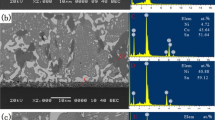Abstract
High-temperature lead-free Bi–11Ag solder with a Sn addition of 1, 3, and 5 wt% was investigated in this paper. The results show that the melting temperature of Bi–11Ag solders dropped from 265 to 255 °C after the addition of Sn, which is suitable for the high-temperature reflow process. When the addition of Sn was 3 wt% or less, dendrites in the microstructure would be refined, however, further additions of Sn show an opposite effect. The contact angle of Bi–11Ag–xSn (x = 0, 1, 3, 5 wt%) solders on the Cu substrate was measured, and the value decreased from 62° to 41° with the increasing of Sn content. The tensile strength of the Cu/Bi–11Ag–xSn solder/Cu sandwich structured microscale solder joint continues to increase from 43.3 to 53.9 MPa and the fracture position evolves from the solder/Cu interface to the middle of solder. In addition, according to EDS analysis of the solder/Cu interface, a Cu3Sn intermetallic compound (IMC) layer can be identified. The combination of this IMC layer and grain boundary grooving at the solder/Cu interface can effectively improve the strength of the Bi–11Ag–xSn solder joint.










Similar content being viewed by others
References
B. Kim, C.W. Lee, D. Lee et al., Effect of Sb addition on Bi-2.6Ag-0.1Cu solders for high-temperature applications[J]. J. Alloy. Compd. 592, 207–212 (2014)
L.M. Yin, D. Li, Z.X. Yao, G. Wang, A. Blackburn, Microstructures and properties of Bi-10Ag high temperature solder doped with Cu element[J]. Microelectron. Reliab. 80, 79–84 (2018)
M. Nahavandi, M.A.A. Hanim, Z.N. Ismarrubie et al., Effects of silver and antimony content in lead-free high-temperature solders of bi-ag and bi-sb on copper substrate[J]. J. Electron. Mater. 43(2), 579–585 (2014)
M. Nahavandi, M.A.A. Hanim, Z.N. Ismarrubie et al., Interfacial reaction of Bi-Ag and Bi-Sb solders on copper substrate with multiple reflow number[J]. Mater. Res. Innovations 18(sup6), S6–S318 (2014)
J.M. Song, H.Y. Chuang, Z.M. Wu, Interfacial reactions between Bi-Ag high-temperature solders and metallic substrates[J]. J. Electron. Mater. 35(5), 1041–1049 (2006)
J.M. Song, H.Y. Chuang, Z.M. Wu, Substrate dissolution and shear properties of the joints between Bi-Ag alloys and Cu substrates for high-temperature soldering applications[J]. J. Electron. Mater. 36(11), 1516–1523 (2007)
G. Zeng, S. McDonald, K. Nogita, Development of high-temperature solders: review[J]. Microelectron. Reliab. 52(7), 1306–1322 (2012)
J.E. Spinelli, B.L. Silva, N. Cheung et al., The use of a directional solidification technique to investigate the interrelationship of thermal parameters, microstructure and microhardness of Bi-Ag solder alloys[J]. Mater. Charact. 96, 115–125 (2014)
Z. Haidong, I. Shohji, M. Shimoda et al., Effect of strain rate and temperature on tensile properties of Bi-based lead-free solder[J]. Mater. Trans. 57(6), 873–880 (2016)
K. Suganuma, S.J. Kim, K.S. Kim, High-temperature lead-free solders: properties and possibilities[J]. J. Miner. Met. Mater. Soc. 61(1), 64–71 (2009)
J.M. Song, H.Y. Chuang, T.X. Wen, Thermal and tensile properties of Bi-Ag alloys[J]. Metall. Mater. Trans. A 38(6), 1371–1375 (2007)
J.M. Song, H.Y. Chuang, Faceting behavior of primary ag in bi-ag alloys for high temperature soldering applications[J]. Mater. Trans. 50(7), 1902–1904 (2009)
J.M. Song, C.H. Tsai, Y.P. Fu, Electrochemical corrosion behaviour of Bi–11Ag alloy for electronic packaging applications[J]. Corros. Sci. 52(7), 2519–2524 (2010)
B.L. Silva, F. Bertelli, M.V. Canté et al., Solder/substrate interfacial thermal conductance and wetting angles of Bi–Ag solder alloys[J]. J. Mater. Sci. 27(2), 1994–2003 (2016)
J.M. Song, Z.H. Chang, Heat resistant Bi-Ag-X solders for power IC die attachment[C]//Electronic Packaging and iMAPS All Asia Conference (ICEP-IACC), 2015 International Conference on. IEEE, 2015 pp 550–553
P. Fima, G. Garzeł, A. Sypień, Wetting of Cu pads by Bi-2.6 Ag-xCu alloys and phase equilibria in the Ag-Bi-Cu system[J]. J. Electron. Mater. 43, 4365–4373 (2014)
M. Shimoda, T. Yamakawa, K. Shiokawa et al., Effects of Ag content on the mechanical properties of Bi-Ag alloys substitutable for Pb based solder[J]. Trans. JWRI 41(2), 51–54 (2012)
J.N. Lalena, N.F. Dean, M.W. Weiser, Experimental investigation of Ge-doped Bi-11Ag as a new Pb-free solder alloy for power die attachment[J]. J. Electron. Mater. 31(11), 1244–1249 (2002)
W. Fang, Y. Shi, Z. Xia et al., Research development of high temperature lead-free solders for electronic assembly[J]. Electron. Compon. Mater. 28(3), 71–74 (2009)
P. Fima, W. Gąsior, A. Sypień et al., Wetting of Cu by Bi–Ag based alloys with Sn and Zn additions[J]. J. Mater. Sci. 45(16), 4339–4344 (2010)
J. Pstruś, P. Fima, W. Gąsior, Surface tension, density, and thermal expansion of (Bi-Ag) eut-Zn alloys[J]. J. Electron. Mater. 40(12), 2465–2469 (2011)
Y. Shi, W. Fang, Z. Xia et al., Investigation of rare earth-doped BiAg high-temperature solders[J]. J. Mater. Sci. 21(9), 875–881 (2010)
T. El-Ashram, Formation of supersaturated solid solutions Bi-Ag and Bi-Zn by rapid solidification using melt spinning technique[J]. Mater. Sci. Appl. 6(02), 183 (2015)
Acknowledgements
This research was supported by the National Natural Science Foundation of China (NSFC) under Grant No. 51674056, the Achievement Transfer Program of Institutions of Higher Education in Chongqing under Grant No. KJZH17137, the Scientific and Technological Research Program of Chongqing Municipal Education Commission under Grant No. KJ1713344, and the State Key Lab of Advanced Welding and Joining, Harbin Institute of Technology under Grant No. AWJ-M15-05.
Author information
Authors and Affiliations
Corresponding author
Rights and permissions
About this article
Cite this article
Yin, L., Li, D., Yao, Z. et al. Effects of Sn addition on the microstructure and properties of Bi–11Ag high-temperature solder. J Mater Sci: Mater Electron 29, 12028–12035 (2018). https://doi.org/10.1007/s10854-018-9308-5
Received:
Accepted:
Published:
Issue Date:
DOI: https://doi.org/10.1007/s10854-018-9308-5




